
Foods of the 1860's
During the Civil War cooking was done in a stone or brick fireplace or over an open fire. Wealthy families might have had a woodburning cast iron stove.
Meats that were prepared ranged from a fresh catch of fish to domestic or wild game when available. The menu included pork, beef, chicken, venison, squirrel, quail, grouse, pheasant, duck, pigeon and turkey. Fresh produce was harvested from nature. Wealthy families had cane sugar while most families would have used honey, maple syrup and molasses as sweetners.
Recipes were common during the 1860’s but there were few printed cookbooks, so the recipes were handed down. Some recipes were collected in a scrapbook or journal.
Only the list of ingredients would have been written out, no directions for preparation would have been mentioned. The cook was expected to remember what to do with the ingredients.
Print these out and start your own Civil War recipe collection scrapbook.
Raspberry Shrub
This shrub, mixed with water, was considered a delicious summer drink. It was also sometimes served instead of Port or other wine.
Raspberries 1 pint sugar to each pint of raspberry juice
Strong vinegar to barely cover
Put raspberries in a pan and scarcely cover them with strong vinegar. Let stand overnight. Squeeze raspberries through cloth for clear juice. Add sugar in proportion and test for flavor. Scald resulting juice, skim it, and then bottle it when cold.
Currant Wine
Those who had more currants than money often made this beverage and used no other wine.
Prepared currant juice 3 ½ lbs. sugar for each 2 quarts of currant juice
Break and squeeze the currants in a cloth for clear juice. Mix sugar and water with juice proportionately and put in a keg or barrel. Do not close the bung tight for 3-4 days that air may escape while it is fermenting. After it is done fermenting, close it up tight.
Where raspberries are plenty, it is a great improvement to use half raspberry juice and half currant juice.
Addition of brandy is not necessary when the above proportions are used. The wine should not be used under a year or two as age improves it.
Sourdough Bread
2½ cups unbleached flour 1 cup sourdough starter*
2 cups blood-warm water
Four hours (or more) before baking, mix flour and water, then add to starter. Cover and let stand in warm place until bubbly.
2 cups freshly doubled starter 2 tsp. salt
3 cups flour (grind 1 lb. wheatberries in 1 tsp. saleratus (baking soda)
coffee grinder if desired) 1 tsp. drippings
In large bowl, mix freshly doubled starter, salt, soda, and flour. When stirring becomes too hard, knead with hands for a few minutes, using flour to prevent sticking. Shape dough into a round loaf and place in greased round pan. With a knife, score lines to shape wedges. Cover with a cloth and let rise 30 minutes.
Bake at 350F for about 45 minutes. Cool before dividing along wedge-shaped lines.
*Sourdough starter may now be purchased. To make starter yourself, Mix together 1 cup flour, 1 cup water, and 1 Tbsp. sugar and let the mixture stand in a warm place 2-3 days or until fermented (or "ripen" by keeping in refrigerator for several days). Before it is ready to use, it must be "fed" to keep it alive. In a bowl, mix another starter mixture and stir into the live starter (called "doubling"). Let set in warm place for several hours until it is bubbly. Return half to the jar; use part to make bread or biscuits and give part to a friend.
Corn Breads
Corn breads differed between North and South because of the different types of corn which were grown in the regions. Flint corn (yellow) is grown throughout the North; in the southern portion of the Corn Belt (from Ohio through southern Tennessee) farmers grow Boone County White.
Corn Pone
Corn bread, quickly picked up by white settlers, was usually called pone (also known as journey cakes and today as johnny cake) when kept out of the ashes. Following the Indian tradition, when the same basic corn bread was baked in the hot ashes of an open fire, it was called ashcake. If it was baked in the fire on a hoe, it was called hoecake.
White corn meal (about 2 cups) Lard or shortening the size of an egg (4 Tbsp.)
Salt (about 1 tsp.) 1 tea-cupful boiling water (about ¾ cup)
Pinch of baking soda (1/4 tsp.) ½ tumbler buttermilk (about ½ cup)
Sift together corn meal, salt, and baking soda. Work in fat with finger tips until well blended. Pour in boiling water and continue to work the mixture. Gradually add enough buttermilk to make a soft dough, but one firm enough to be molded or patted into small, flat cakes. Place cakes in a hot, well-greased iron skillet and bake in a moderate oven (about 350F) for 35-40 minutes. Makes about 12.
Corn pone should be eaten hot. Serve with butter, molasses, maple syrup, or honey.
Spoon Bread
A famous southern dish, spoon bread originated as the Indian porridge, suppawn, and still retains the consistency of a porridge or pudding. It would have been inexcusable to make Spoon Bread with the yellow northern flint corn; it was always made with ground white corn. Corn bread as we know it today is much lighter and sweeter than Civil War period corn bread.
Butter the size of a large egg (5 Tbsp.) 1 pint boiling water
Water-ground corn meal (about 1 cup) ½ pint cold milk
Salt (about a tsp.) 4 eggs
Put butter in a medium-sized earthenware or glass baking dish and place in oven to melt while you prepare the batter.
Combine corn meal and salt in a mixing bowl and stir in boiling water until smooth. Let stand several minutes, then stir in milk. Add the eggs, one at a time, beating hard after each addition. Stir in melted butter last of all. Pour batter into the hot baking dish and bake in a hot oven (about 425F) for about 25-30 minutes.
Serve hot, right from the baking dish, with plenty of extra butter. Serves 4.
Beef Stew
This was a simple way to provide a meal, even for an inexperienced cook. Stew was constantly over the fire in some homesteads, being added to daily. As a homemaker gained experience, she developed her own personal recipe tailored to the likes of her family.
Rump of beef Salt and pepper
1 pint small beer Lemon peel
Carrots Sweet herbs*
Onion with cloves in it Celery
Cut the meat from the bone, flour and fry it. Pour over it a little boiling water and about a pint of small beer; add carrots, an onion stuck with cloves, some whole pepper, salt, a piece of lemon peel, a bunch of sweet herbs and let it stew an hour. Then add some good gravy. When the meat is tender, take it out and strain the sauce; thicken it with a little flour. Add a little celery already boiled, potatoes already boiled, a little catchup (tomato or walnut ketchup), then the meat and just simmer it up.
Or the celery may be omitted, and the stew enriched by adding fresh or pickled mushrooms, boiled and quartered artichoke-bottoms, and hard yolks of eggs. A piece of flank, or any piece that can be cut free from bone, will do instead of the rump.
* Sweet herbs would have been parsley, sweet marjoram, winter savory, orange and lemon thyme. The greatest proportion was the parsley.
Eggs and Cream
½ pint cream Salt and pepper
8 eggs
Boil cream until reduced by half. Add the eggs; season with salt and pepper. Boil them together until eggs are mostly hard. Pass a salamander (browner) over the top and serve hot.
Potato Soup
1 quart potatoes, peeled and cubed 1½ quarts chicken broth
1 carrot, pared 1 cup stale bread crumbs
2 stalks celery
Place the potatoes, carrot, and celery in a soup pot with one quart of the bouillon. Cook, covered, for 10 minutes or until the potatoes are soft. Add the bread and cook 10 minutes longer. Put through a food mill or blender. Return the puree to the soup pot; add the remaining bouillon and heat 3 minutes longer. Correct the seasonings (to suit your taste). Serves 6.
Baked Beans
As with many other foods, baked beans of the 1860’s were not as sweet as they are today. Civil War soldiers on both sides had baked beans for breakfast when the opportunity arose. They were cooked over or in the campfire all night. It was not often, except during winter, that an army unit could plan to be in the same camp long enough to cook beans fresh during the day, nor would they have been likely to have the saleratus (baking soda) to soften the beans while on the march.
Water ¼ cup molasses
3 cups dried navy or pea beans 3 small onions, cut in chunks
1 tsp. saleratus (baking soda) 2 green peppers, cut in strips
¼ to ½ lb. salt pork
The night before cooking, put beans in saucepan or kettle to soak overnight in water to cover generously (a quart or more). Drain the next morning and refill kettle with water; simmer five minutes. Stir in soda to dissolve. Continue to simmer for about 40 minutes, then test beans for tenderness.
Drain liquid off the tender beans and pour in 5 cups fresh water. Return to simmer, adding salt pork. In 30 minutes pour off extra liquid (save for bean soup or to add later to beans)
Grease a casserole by rubbing with salt pork; leave salt pork in pan. Prepare vegetables and stir into beans. Put mixture in casserole with salt pork. Drizzle ¼ cup molasses over top and add bean water to cover.
Beans can be baked at 250F for 8 hours or at 350F for 4 hours . You may need to add additional bean water so the beans do not dry out. Serve with a small pitcher of molasses.
Pound Cake
1 lb. flour, sifted ½ glass brandy
1 lb. white sugar, powdered and sifted ½ glass rose-water
1 lb. fresh butter 12 drops essence of lemon (extract)
10 eggs 1 table-spoonful mixed mace and cinnamon
½ glass wine 1 nutmeg, powdered
Pound the spice and sift it. There should be twice as much cinnamon as mace. Mix the cinnamon, mace, and nutmeg together. Sift the flour in a broad pan or wooden bowl.
Sift the powdered sugar into a large deep pan, and cut the butter into it in small pieces. If the weather is very cold and the butter hard, set the pan near the fire for a few minutes. If the butter is too warm, the cake will be heavy. Stir the butter and sugar together with a wooden stick until they are very light and white and look like cream (cream thoroughly).
Beat the eggs in a broad shallow pan with a wooden egg-beater (or whisk). They must be beaten till they are thick and smooth and of the consistence of boiled custard.
Pour the mixed liquor and rose-water gradually into the butter and sugar, stirring all the time. Add by degrees, the essence of lemon and spices.
Stir the egg and flour alternately into the butter and sugar with a handful of flour and about 2 spoonfuls of the egg (which you must continue to beat all the time). When all is in, stir the whole mixture very hard for near 10 minutes.
Butter a large tin pan or cake mould with an open tube rising from the middle. Put the mixture into it as evenly as possible. Bake in moderate oven (about 350F) for 2 - 3 - 4 hours (? – watch before this amount of time in modern oven) in proportion to its thickness and to the heat of the fire.
When you think it is nearly done, thrust a twig or wooden skewer (often a clean broom straw, now a cake tester) into it down to the bottom. If the stick comes out clean and dry, the cake is almost baked. When quite done, it will shrink from the sides of the pan and cease making a noise. Then withdraw the coals (if baked in a Dutch oven, coals were put on top of the oven in an effort to keep heat even), take off the lid and let the cake remain in the oven to cool gradually.
You may ice it either warm or cold. Before you put the icing on a large cake, dredge the cake all over with flour, and then wipe the flour off. This will make the icing stick on better. If you have sufficient time, the appearance of the cake will be much improved by icing it twice. Put on the first icing soon after the cake is taken out of the oven, and the second the next day when the first is perfectly dry. While the last icing is moist, ornament it with colored sugar-sand or nonpareils.
Pumpkin or Squash Pie
When made for the family, this pie was often made with 1 egg to a quart of milk. The feeling was, the more eggs, the better the pie. So some used 1 egg for each gill of milk for company dessert.
Pumpkin or squash 2 tea-spoonfuls salt
3 eggs 2 great spoonfuls sifted cinnamon
1 quart milk 1 great spoonful ginger
Molasses or sugar Grated lemon peel (optional)
Take out the seeds and pare the pumpkin or squash before stewing but do not scrape the inside. The part nearest the seed is the sweetest part of the squash. Stew pumpkin and strain through a sieve or colander (or beat with mixer).
Stir the stewed pumpkin or squash into the milk beaten with eggs until it is as thick as you can stir it round rapidly and easily. To make the pie richer for company, make it thinner and add another egg. A decent pie can be made with only one egg to a quart of milk for everyday. Sweeten to taste with molasses or sugar. Some pumpkins require more sweetening than others. Ginger alone will be enough for spice if you use enough. A little grated lemon peel is nice.
Put in paste (pastry) shell. Bake without top crust for 40-50 minutes in moderate oven (350F), or longer if very deep.
Colored Almonds
The same coloring matters used to color these almonds was also used to color other foods when needed. These were considered a confection for a special occasion and were sometimes used as a table favor wrapped in white paper and tied with a ribbon.
Almonds Vegetable liquid (broth) with coloring
Blanch almonds and cut in small pieces (slivers). Put them on a baking plate and pour on them a little of any coloring infusion. Then rub them in your hands to mix them well with the color. When all are so done, dry them in a slow oven (about 200-250F). Watch that the coloring, when done, is light and delicate. Serve with colors either mixed or separate in paper cases.
Coloring:
Infuse (steep) vegetable liquid with the appropriate coloring ingredient for as long as it takes to get the degree of coloring you desire.
For rose color: Infuse cochineal or carmine (both red dyes from cochineal, purchased at an apothecary)
For violet: Infuse a little cochineal with indigo (dark blue dye, purchased at an apothecary) dissolved in water. Use only a small quantity in water as it is very strong.
For green: Take 2 handfuls of fresh spinach, Wash it well, drain and pound very fine, and press through napkin. Let the juice drip on a dish; then place the dish on a hot stove. When the juice
begins to boil, take it off and stir constantly until the green curdles. Then pour it through a very fine sieve. When well drained, strain through a tammy (silk sieve). The juice thus obtained will give the almonds a clean and even green color.
For blue: Dissolve a little indigo in water and strain it through a cloth.
For orange: Infuse a little liquid red and a little infusion of saffron together.
For yellow: Infuse a small quantity of saffron in nearly boiling water for a few minutes; strain.
For chocolate color: Dissolve chocolate in hot water and strain.
Chestnuts
Place chestnuts on the fire in a pan with holes to roast them, first slitting or cutting a notch in the skins to prevent them from flying off (exploding). When done, serve them as dessert as hot as possible.
Some boil the chestnuts instead of roasting them as the skins are cleaner, but the nuts are not quite so mealy. The best way is to boil them in plenty of water and when nearly done, take them out and roast them.
American Snow Balls
Rice Lemon peel to taste
Milk Cinnamon to taste
5-6 apples Linen squares
Boil some rice in milk (about equal parts of each, amount to depend on the size of your apples) till it be swelled and soft. Pare and carefully scoop out the core of five or six good-sized apples. Put into each a little grated lemon peel and cinnamon. Place as much rice as will cover an apple upon a bit of linen. Tie each closely and boil 2 hours. Serve with melted butter sweetened with sugar
Puddings
Puddings were by far the most common types of dessert in the 1700’s and 1800’s. This was partly because of limited cooking facilities in most households of the period. A pudding could be cooked and kept warm in a cast iron pot near the fire for hours until needed. Just about everything was used to make a pudding – fruits, vegetables, grains, nuts, and dairy products.
Puddings were easy to prepare and generally used inexpensive ingredients at hand and only limited amounts of more expensive ingredients. Richer custards and puddings with expensive or hard-to-obtain ingredients were usually reserved for "company meals." Although some puddings were baked in a deep dish in the oven, most were tied in a closely woven fabric bag and put into already boiling water to cook.
Raspberry Cream
6 oz. raspberry jam Juice of 1 lemon
1 quart cream Sugar
Mix jam into cream and put through a lawn (finely woven thin linen or cotton fabric) sieve. Mix with lemon juice and a little sugar to taste. Whisk until thick. Serve in a dish or glasses.
Strawberry Cream can be made in the same manner. For common use, substitute good milk for the cream.
Common Custard
For everyday use this custard was also flavored (instead of with costlier spices) with a little lemon peel or with peaches leaves boiled in the milk and afterwards strained from it before adding other ingredients. Either of these was said to also give a pleasant flavor.
5 eggs Cinnamon
1 quart milk* Nutmeg
Brown sugar Little salt
Mix eggs and milk. Sweeten to taste with brown sugar. Spice with a small amount of cinnamon and/or nutmeg. Bake 15-20 minutes.
* It is well to boil your milk and set away till it is cold. Boiling the milk enriches it so that boiled skimmed milk is about as good as new milk.
Bread Pudding
This was another way to use stale and dry bread. It well illustrates the old belief, "Waste not, want not."
Stale bread Pinch of cinnamon
Milk Spoonful of rose-water or lemon-brandy
3 eggs 1 tea-cupful molasses or sugar
Pinch of salt Raisins
4 eggs
Crumble the bread the night before you want to serve it in the morning and soak overnight in milk. In the morning, beat the eggs with the bread and add salt. Tie it up in a bag, or in a pan that will exclude every drop of water. Boil it about an hour or a little more. When tied in a bag, no pudding should be put into the pot till the water boils.
Honey Cakes
1½ lb. sifted flour ½ oz. orange peel, cut small
¾ lb. honey ¾ oz. pounded ginger (powdered)
½ lb. finely pounded loaf sugar ¾ oz. pounded cinnamon (powdered)
¼ lb. citron
Melt the sugar with the honey, and mix in other ingredients. Roll out the paste (pastry) and cut into small cakes (cookies) of any form. Bake in moderate oven (350-375F).
Snickerdoodles
Very few people realize these still-popular cookies date as far back as the Civil War. At that time, snickerdoodles were often made with dried currants or raisins included. Try making them with a 50/50 mixture of all-purpose white flour and whole wheat flour. The taste difference is not dramatic but very good. It is approximately the same as these cookies would have tasted to the Civil War soldiers who received them in a box from home.
Although there is no baking powder in these cookies (it was not yet widely available in the 1860’s, but the cream of tartar and saleratus was an approximate substitute), they will puff up at first and then flatten out with crinkled tops.
2¾ cups flour 1½ tea-cupfuls sugar
2 tea-spoonfuls cream of tartar 2 eggs
1 tea-spoonful saleratus (baking soda) 2 table-spoonful sugar
½ tea-spoonful salt 2 tea-spoonfuls cinnamon
1 cup butter
Cream butter, gradually adding sugar and then eggs. Sift dry ingredients together. Gradually beat into creamed mixture. Chill dough.
Form into balls the size of small walnuts. Roll in a mixture of 2 Tbsp. sugar and 2 tsp. cinnamon. Place on a tin sheet (ungreased) and bake in a hot oven (about 400F) until lightly browned but still soft (about 10 minutes).
Posted by Blue Bellied Yank at 5/06/2007 12:14:00 PM 0
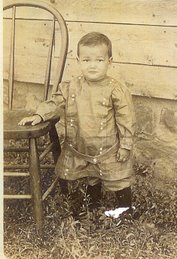
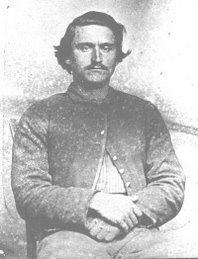

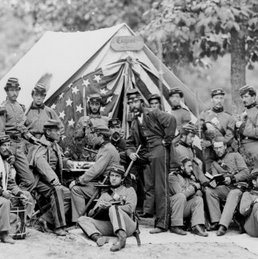

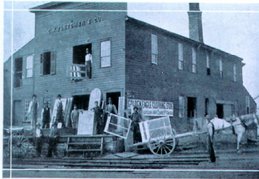
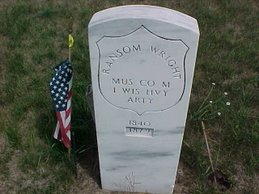

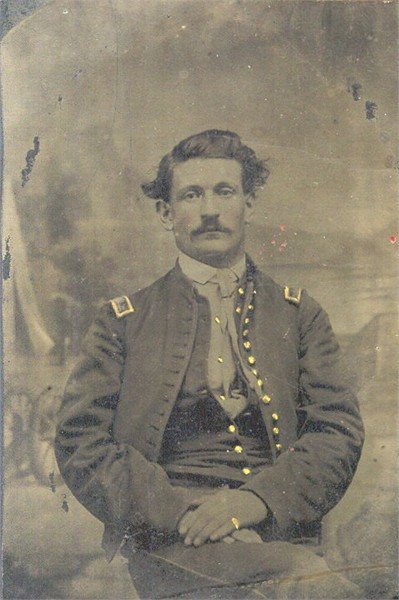
2 comments:
Looks like I've got a lot of cooking ahead of me!! Great post -- great blog! Keep up the fine posts!
You'll have lots of recipes to try out at your reenactments...
Post a Comment